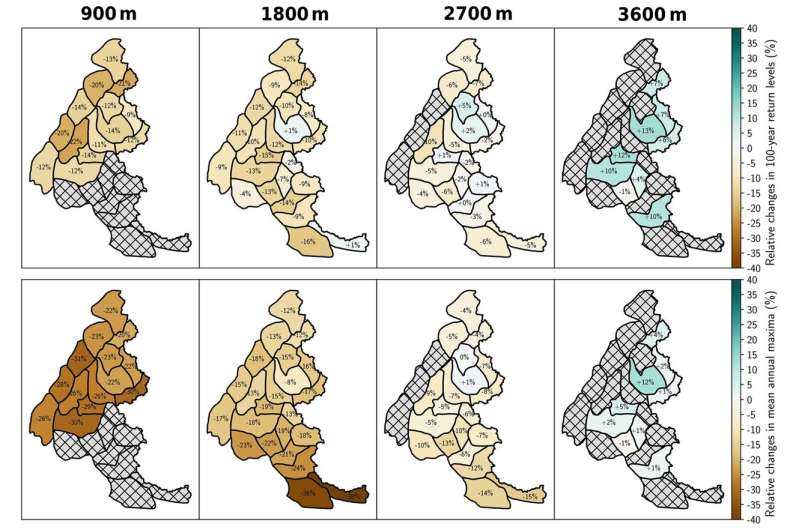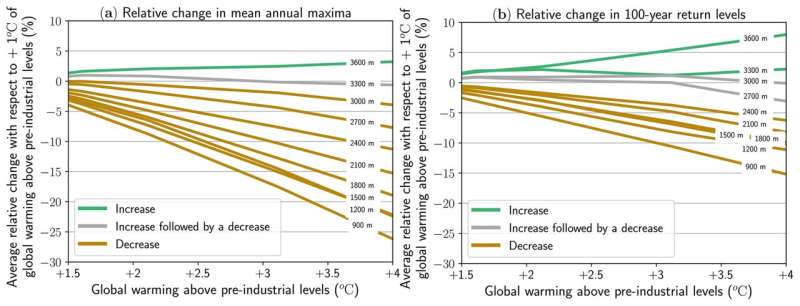November 14, 2023 feature
Climate change increasing likelihood of extreme snowfall in the French Alps, research suggests
Hannah Bird
guest writer

Global warming is often cited as having a negative impact on snow and ice melt in cold regions, yet new research in The Cryosphere has suggested that extreme snowfall events may be a feature of some locations at higher latitudes and elevations in the decades to come.
Meanwhile, the warming effect at low-medium mountain elevations is predicted to instead enhance extreme precipitation, with a 7% increase in rainfall per 1°C of warming globally. This contrast is likely to have consequences for the communities living in these environments, who rely on the regularity of snowfall for livelihoods, such as tourism and the skiing industry, as well as being able to mitigate against hazards like avalanches.
Dr. Erwan Le Roux, a Postdoctoral Researcher at the University of Grenoble Alpes, France, and colleagues investigated the changes in extreme snowfall annually and over a century in the French Alps in response to different mountain elevations (900–3,600 m) and global warming potential (GWP).
GWP is a measure of the warming ability of a particular gas to trap heat in the atmosphere, with carbon dioxide chosen as the reference. The research used a climate model under Representative Concentration Pathway 8.5, the worst-case baseline greenhouse gas emissions scenario, which predicts Earth's temperature will increase by 4.3°C by 2100 relative to pre-industrial levels.
The scientists studied 23 massifs across the French Alps, inputting real data from ground measurements of temperature and daily precipitation and meteorological forecasts from 1951 to the present day in order to predict changes over the remainder of this century under +1°C of global warming.
They found that daily mean annual snowfall increased considerably at elevations above 3,600 m but decreased below 3,000 m, instead experiencing more precipitation, while over 100 years the average elevations decrease for both situations with increased snowfall above 3,300 m but reduced below 2,400 m.
In summary, this means the threshold at which the net balance of snowfall shifts above 0% changes from 3,000 m at +1.5°C warming to 3,300 m at +4°C for the annual mean, an elevation increase of 123 m per +1°C of warming, the steepest increase of which occurs above +3°C.
Numerous ski resorts in the French Alps have the upper limits of their altitude ranges above the 2,400 m elevation, such as Chamonix (reaching up to 3,275 m) and Les Deux Alpes (up to 3,600 m), meaning the local economy could be severely impacted by a loss of snowfall reducing skiing capacities.

This pattern was consistent up until +3°C of global warming, after which elevations experiencing significant precipitation and snowfall changes decreased further, reaching a low of 900 m at +4°C of global warming (26% reduction in snowfall annually). The trend was most evident in the south of the French Alps, where the Mercantour massif is projected to experience a 39% reduction in mean annual snowfall at 1,800 m elevation.
Conversely, the largest positive shift in mean annual snowfall is projected for the northeastern Vanoise massif, with a 12% increase at 3,600 m, occurring predominantly during boreal winter months (December–February).
Three distinct phase patterns were determined: 1) an increase in intense snowfall due to enhanced winter precipitation and extreme temperatures at or below freezing; 2) an increase and then decrease in snowfall at +3°C and elevations of 3,000 m due to experiencing temperatures too high for snow formation; 3) decrease in snowfall at elevations below 3,000 m, again due to not reaching optimal freezing temperatures.
This research is vitally important to translate across other cold mountainous regions to help local communities plan for future changes in snowfall events, implementing environmental and socioeconomic management strategies that enable them to survive.
Written for you by our author —this article is the result of careful human work. We rely on readers like you to keep independent science journalism alive. If this reporting matters to you, please consider a (especially monthly). You'll get an ad-free account as a thank-you.
More information: Erwan Le Roux et al, Projection of snowfall extremes in the French Alps as a function of elevation and global warming level, The Cryosphere (2023).
Journal information: The Cryosphere
© 2023 Science X Network


















